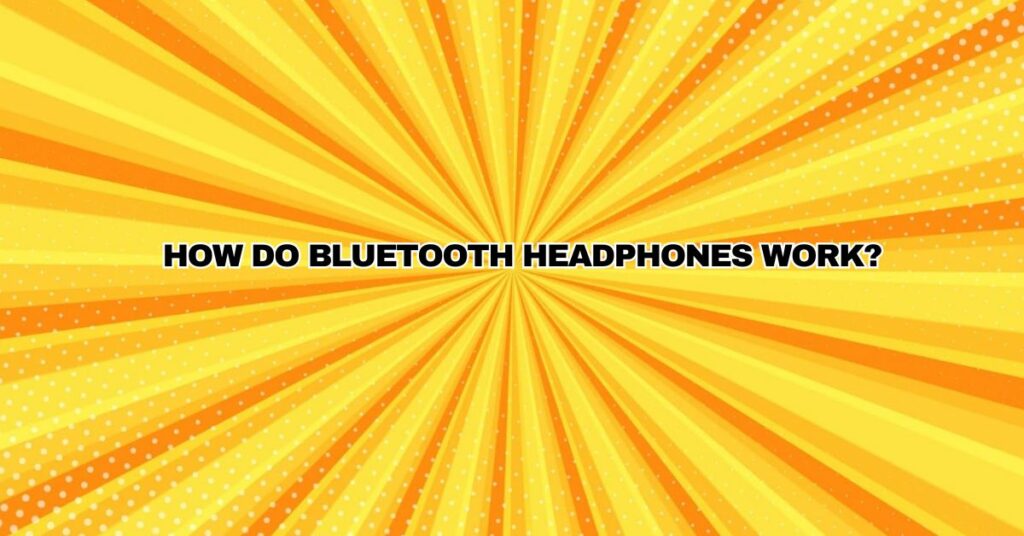Bluetooth headphones have revolutionized the way we listen to music, take calls, and enjoy audio content. These wireless wonders have become ubiquitous in our daily lives, offering unparalleled convenience and eliminating the hassles of tangled cords. But have you ever wondered, “How do Bluetooth headphones work?” In this comprehensive guide, we’ll explore the technology behind Bluetooth headphones, their key components, and the intricate processes that enable seamless wireless audio.
Understanding Bluetooth Technology:
Bluetooth technology is a short-range wireless communication standard that allows devices to connect and exchange data over short distances. It operates in the 2.4 GHz ISM (Industrial, Scientific, and Medical) band and uses radio waves to establish connections between devices. This technology is used for various applications, including wireless headphones.
Key Components of Bluetooth Headphones:
Bluetooth headphones consist of several key components that work together to deliver wireless audio:
- Bluetooth Chipset: At the core of Bluetooth headphones is a Bluetooth chipset, which includes a Bluetooth radio and a microcontroller. The microcontroller manages the connection and communication between the headphones and the paired device.
- Speakers/Drivers: Bluetooth headphones have built-in speakers or drivers that convert electrical signals into sound waves. These drivers are responsible for delivering audio to your ears.
- Battery: Most Bluetooth headphones are powered by rechargeable lithium-ion or lithium-polymer batteries. These batteries provide the necessary energy to operate the headphones wirelessly.
- Buttons and Controls: Bluetooth headphones are equipped with physical buttons, touch controls, or capacitive sensors for functions such as volume adjustment, play/pause, skip tracks, and answer/end calls.
- Microphone: To facilitate phone calls and voice commands, Bluetooth headphones feature a built-in microphone that captures your voice.
- Charging Port: This port is used for recharging the headphones’ battery. It can be a micro-USB, USB-C, or proprietary connector.
- Audio Codecs: Bluetooth headphones support various audio codecs (e.g., SBC, AAC, aptX) to ensure high-quality audio streaming over the wireless connection.
How Bluetooth Headphones Work:
The operation of Bluetooth headphones involves a series of steps that allow them to connect to a source device and transmit audio wirelessly:
1. Pairing:
- The initial setup involves pairing your Bluetooth headphones with a compatible source device, such as a smartphone, tablet, or computer.
- The headphones enter “pairing mode,” during which they become discoverable to nearby devices.
- You initiate the pairing process on your source device, which searches for available Bluetooth devices.
- Once your headphones are detected, you select them on your source device to establish a connection.
2. Connection:
- Once the pairing is successful, your headphones and the source device establish a Bluetooth connection.
- The source device becomes the “master,” while the headphones become the “slave” in this connection.
3. Audio Streaming:
- The source device streams audio data, such as music, podcasts, or phone calls, to the headphones.
- The audio data is converted into electrical signals and transmitted wirelessly to the headphones.
4. Decoding and Playback:
- Upon receiving the audio data, the Bluetooth chipset in the headphones decodes it using the selected audio codec.
- The decoded audio signals are then sent to the headphone’s speakers or drivers.
- The drivers convert the electrical signals into sound waves, which are heard in your ears as music or other audio content.
5. Two-Way Communication:
- Bluetooth headphones not only receive audio data but can also transmit data back to the source device.
- The built-in microphone in the headphones captures your voice during phone calls or voice commands.
- The headphones transmit your voice data to the source device, enabling two-way communication.
6. Control and User Input:
- Bluetooth headphones are equipped with buttons or controls that allow you to adjust volume, play or pause music, skip tracks, and answer or end calls.
- These controls send signals to the headphones’ microcontroller, which interprets and executes the desired actions.
7. Battery-Powered Operation:
- Bluetooth headphones are powered by a built-in rechargeable battery, which provides the necessary energy for all their functions.
- The battery can typically provide several hours of continuous use before requiring recharging.
8. Auto-Connect and Reconnection:
- Many Bluetooth headphones have a feature that allows them to auto-connect to the last paired device when powered on.
- If the headphones are powered off or disconnected, they can automatically reconnect when brought within the Bluetooth range of the paired device.
9. Range and Stability:
- Bluetooth headphones operate within a limited range, usually around 33 feet (10 meters) from the source device.
- The quality of the connection can be affected by physical obstructions, signal interference, and the Bluetooth class (Class 1, Class 2, Class 3) supported by the headphones.
10. Audio Codecs: – The choice of audio codec can impact the quality of audio streaming. High-quality codecs like aptX and AAC offer superior sound fidelity compared to the standard SBC codec.
Common Use Cases:
Bluetooth headphones find applications in various scenarios, including:
- Listening to music and audio content wirelessly.
- Making and receiving phone calls hands-free.
- Participating in video conferences or online gaming.
- Engaging in physical activities like jogging or working out.
- Enjoying audio entertainment during commutes or travel.
In Summary:
Bluetooth headphones work by establishing a wireless connection with a source device, receiving audio data, decoding it, and playing it through built-in speakers or drivers. They allow for seamless, wire-free audio streaming and offer user controls for convenience. Understanding the technology and processes behind Bluetooth headphones can help you appreciate their functionality and make the most of your wireless audio experience.


